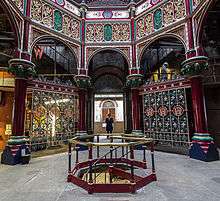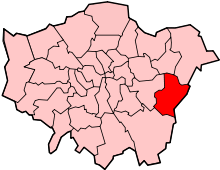Crossness Pumping Station
| Crossness Pumping Station | |
|---|---|
|
Western exterior of the Crossness Pumping Station | |
| Location |
Crossness Sewage Treatment Works London, SE2 United Kingdom |
| Coordinates | 51°30′33″N 0°08′18″E / 51.509142°N 0.138418°E |
| OS grid reference | TQ4849781080 |
| Built | 1859–1865 |
| Architect | Charles Henry Driver and Joseph Bazalgette |
| Architectural style(s) | Romanesque |
| Owner | Thames Water |
Listed Building – Grade I | |
| Designated | 24 June 1970 |
| Reference no. | 1064241 |
 Location of Crossness Pumping Station in Greater London | |
The Crossness Pumping Station is a former sewage pumping station designed by the Metropolitan Board of Works's Chief Engineer Sir Joseph Bazalgette and architect Charles Henry Driver at the eastern end of the Southern Outfall Sewer in the London Borough of Bexley. Constructed between 1859 and 1865, as part of Bazalgette's redevelopment of the London sewerage system, it features spectacular ornamental cast ironwork, that Nikolaus Pevsner described as "a masterpiece of engineering – a Victorian cathedral of ironwork".
It is adjacent to Erith Marshes, a grazing marsh, the northern part of which is designated as Crossness Nature Reserve. This provides a valuable habitat for creatures ranging from moths to small amphibians and water voles.[1]
Opening
The Southern Outfall Works, as the complex was originally called, was officially opened on 4 April 1865, by Edward, Prince of Wales, attended by Prince Alfred, the Duke of Cambridge, Prince Edward of Saxe-Weimar, the Archbishop of Canterbury, the Archbishop of York and the Lord Mayor of London, and many other persons of rank.[2]
Following an address by Joseph Bazalgette, the Royal party toured the works and reservoirs, and the Prince then turned the wheel which started the engines and, as the Illustrated London News observed, "a sensible vibration was felt throughout the building, showing that the enormous beams, lifting-rods and flywheels were in operation."[2]
Operation
At Crossness, the incoming liquid was raised some 30 to 40 feet (9–12 m) by the application of four large steam driven pumps. The engines were of enormous size and power. They were built by James Watt & Co. to Joseph Bazalgette's designs and specification, and were named "Victoria", "Prince Consort", "Albert Edward" and "Alexandra".[3]
At 11 revolutions per minute, 6 tons (approximately 1,500 imp gal or 6,800 l) of sewage per stroke per engine were pumped up into a 27-million-imperial-gallon (120,000 m3) reservoir, and was released into the Thames during the ebbing tide.[3][4] The steam required to power these engines was raised by 12 Cornish boilers with single "straight-through" flues situated in the Boiler House to the south of the Engine House, and which consumed 5,000 tons of Welsh coal annually.[3]
The Crossness Works merely disposed of raw sewage into the river seawards, and in 1882, a Royal Commission recommended that the solid matter in the sewage should be separated out, and that only the liquid portion remaining should be allowed, as a temporary measure, to pass into the river. In 1891, sedimentation tanks were added to the works,and the sludge was carried by steam boats and dumped further out into the estuary, at sea.[3]
By 1897, additional pumping capacity was needed, and four extra pumps operated by triple-expansion steam engines were installed in an extension, designed to fit in with Bazalgette's main engine house, to the north of the older building. Later, in 1899, a further increase in London's population necessitated an increase in the efficiency of the original Watt engines, and considerable alteration to their design was carried out by Goodfellow and Co of Hyde, Manchester, for London County Council. They were converted from simple to compound engines with the original single cylinders were augmented by high and intermediate pressure cylinders. The additional steam required was provided by replacing the earlier Cornish boilers by more efficient Lancashire boilers with double flues and in 1901 the improved engines were fully working.[3]
In 1913, the triple expansion steam engines were replaced by diesel engines, which are still to be seen in the triple expansion engine house, and by 1956, the Watt-Goodfellow engines had been decommissioned, (Prince Consort having been temporarily put back in steam in 1953 to assist with draining the flooding of the eastern Royal Arsenal and Abbey Wood) and were left, with the rest of the ironwork, to rust and to vandals.[3]
Restoration


The pumping station became a Grade I listed building[5] in 1970 and will remain on the Heritage at Risk Register until the restoration is completed.[6] The Crossness Engines Trust, a registered charity, was formed in 1987 to oversee the restoration project[7] which was due to be completed in 2013.
When the pumping station was decommissioned in the 1950s it was not considered economic to dismantle the engines as the cost of doing so far exceeded any scrap value. The more valuable metal items (made from brass) such as the engine oilers, much pipework and even the handrails from the stairs were removed. The remaining building and engines were left to suffer considerable vandalism and decay.
As Prince Consort was to the last steam engine to run, in 1953, it is this engine on which the restoration activity has been concentrated. After some fifteen years of effort the engine is now working again and is run on the open days organised by the Trust.
When the buildings were abandoned, the pumps and culverts and all the below ground level areas below the Beam Engine House were filled with sand to reduce the risks from methane. This has meant that some 100 tons of this sand has had to be excavated from around and underneath the pumps before there was any hope of moving the beam and flywheel. Further, there was a considerable ingress of rain water which has resulted in serious rusting of the engine parts.
The station contains the four original pumping engines, which are thought to be the largest remaining rotative beam engines in the world, with 52 ton flywheels and 47 ton beams. Although the engines are original, they are not in their original 1864 configuration as all four engines were converted from single cylinder to the current triple expansion operation in 1901 and 1902. Prince Consort was returned to steam in 2003 and now runs on Trust Open Days. The other engines are not in working order, although work has begun on the restoration of Victoria.
The original boilers did not survive and Prince Consort is now steamed by a small 'off the shelf' boiler. This boiler has nowhere near the steam capacity of the originals, but this is not a problem as the engine no longer operates under load.
Museum
Having received over £2 million in initial funding, including, in 2008, £1.5 million from the Heritage Lottery Fund,[8] £150,000 from English Heritage[8] and £700,000 in match funding from the Department for Communities and Local Government,[9] work began at the site to build an access road, protect the buildings and to develop a museum. Financial and other support was also provided by Thames Water, Tilfen Land, the London Borough of Bexley and the City Bridge Trust.[10]
A further £1.5 million in funding from the Heritage Lottery Fund was secured in April 2015, the 150th anniversary of Crossness's official opening.[11] This was to help fund a museum exhibition focused on the "Great Stink" of 1858 and the role of Crossness in improving London's sewerage system.
In popular culture

The pumping station has been used as a filming location for the 2009 film Sherlock Holmes[12] and for the 2011 BBC production of Michel Faber's The Crimson Petal and the White.[13] The building was also used as the setting for the final mission of the video game The Getaway: Black Monday.[14] The 2003 BBC Series Seven Wonders of the Industrial World: The Sewer King episode featured a segment filmed in the pumping station.
Images
- Exterior detail.
- Exterior.
 Beam Floor.
Beam Floor. The Prince Consort fly wheel in action.
The Prince Consort fly wheel in action. The Prince Consort main beam in action.
The Prince Consort main beam in action.- Restored interior decoration.

- Interior original paintwork.
- Restored decoration.
- Restored decoration.
- Restored decoration.
See also
- Abbey Mills Pumping Stations – a pumping station for the Northern Outfall Sewer.
- Markfield Beam Engine and Museum
References
- ↑ "Crossness Nature Reserve". Thames Water. 11 February 2013. Retrieved 7 August 2013.
- 1 2 "The official opening". The Crossness Pumping Station. The Crossness Engines Trust. 2012. Retrieved 8 August 2013.
- 1 2 3 4 5 6 "The Engines". The Crossness Pumping Station. The Crossness Engines Trust. 2012. Retrieved 8 August 2013.
- ↑ The Crossness Engines. London: The Crossness Engines Trust. 1995.
- ↑ Historic England. "Crossness Pumping Station (Grade I) (1064241)". National Heritage List for England. Retrieved 7 August 2013.
- ↑ Heritage at Risk: Crossness
- ↑ Charity Commission. The Crossness Engines Trust, registered charity no. 297585.
- 1 2 "Historic pump station gets £1.5m". BBC. BBC. 12 November 2008. Retrieved 24 June 2015.
- ↑ "Crossness Engines". London Borough of Bexley. London Borough of Bexley. Retrieved 24 June 2015.
- ↑ "Crossness today (12 November 2008)". Greenwich Industrial History. Greenwich Industrial History. Retrieved 24 June 2015.
- ↑ "Westminster historian secures Lottery funding for Crossness Engines Trust". University of Westminster. Retrieved 24 June 2015.
- ↑ Plowman, Paul. "Sherlock Holmes (2009) – Blackwood descends to the sewers". British Film Locations. Retrieved 7 August 2013.
- ↑ "What We Do – April 2011 – Crossness Engines Trust". Film London. April 2011. Retrieved 14 September 2014.
- ↑ "The Getaway – London gets a virtual makeover". BBC London. BBC News. November 2004. Retrieved 7 August 2013.
External links
| Wikimedia Commons has media related to Crossness Pumping Station. |
- Crossness Pumping Station – official website
- Historic England. "South east workshops – Grade II (198747)". Images of England.
- Historic England. "South west workshops – Grade II (432966)". Images of England.
- Profile from Hidden London
- Pictures of Crossness Pumping Station
- Video of Prince Consort engine working
- Video of Prince Consort Corliss valve gear
Coordinates: 51°30′32.6″N 00°08′18″E / 51.509056°N 0.13833°E
